Among birds
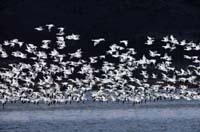
When we see birds, it seems that flying is very easy, that is, it would be enough to have feathers in our arms to fly. And it is true that the flying birds do it thanks to the wings, and that the wings owe that capacity to the feathers.
When the wings move down, the feathers are placed together forming a rigid, airtight structure. This movement pushes the air down and the birds rise. When it is the turn to move the wings up, the feathers turn and let the air pass between the feathers. The air feather resistance in this position is ten times lower than that applied in the previous movement. Several cycles of these characteristics make birds acquire height and fly.
But moving the wings is not a simple activity. Birds need a lot of energy to move the chest muscles and wings. In addition, they need very fast energy to continue with the flight. To get energy from the foods they eat, they need to burn food and they need oxygen. They also need oxygen quickly. To respond to this demand the lungs of birds are adapted, there are no other animals that have lungs like them. They have a system of air sacks that allow a very effective breathing.
Of course, food and oxygen should quickly reach the muscles that move the wings. Therefore, it is necessary that the blood that carries them have a fast speed. The heart of birds beats very fast and, for greater effectiveness, the heart is usually very large (in proportion 6 times greater than the human). Due to rapid circulation, the body temperature is between 7 and 8 degrees higher than that of man, which makes the proteins responsible for metabolism work faster, i.e. burn food faster. In short, birds live very fast.
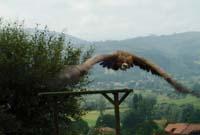
In this fast pace of life, it is also very important that it be light, so that the wings have the least energy possible to keep the animal in the air. In short, the heavier the bird, the greater the number of wings and muscles needed to rise and the greater energy to move them. To relieve weight, birds have turned to bones: the bones are empty inside.
Ways to fly
The moment they need the most energy is the time to fly, as the wings have to make enough strength to raise the weight of the bird. In addition to waving the wings, the animal needs another type of help to take off. Small birds just have to jump and beat their wings to fly. Older ones require stronger propulsion. Many of those who inhabit the water, like the albatrosa, begin to run and when they reach the necessary speed, shake the wings.
If at the beginning of the flight there is opposite wind, it is easier to take off, opening the wings and raising slightly, since the wind passes under the wing with force, causing an ascending force. The higher the bird, the stronger it will have to do to take off. To avoid this problem, many times large birds are placed at high points (ecclesiastical towers, rocky...) and only have to let themselves fall from them to fly.
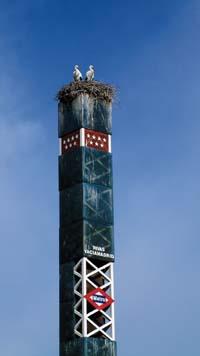
Once they have managed to take off, it is time to fly. Each bird flies in its own way, but in general we can distinguish two basic forms: planning or waving the wings.
Planning is a great advantage as birds save energy when flying. Landbirds use to fly the hot air masses that produce the soil (they take advantage of other wind currents that are generated in the water by aquatic planners and, above all, marine, but this time we will limit ourselves to terrestrial birds). When the sun warms, the air around the ground is also heated and as hot air weighs less than cold (because it has less density) increases. They are thermal currents.
There are other ascending currents, for example, when the wind blows against a mountain, cliff or building, it tends to pass over it and rises. Gliding birds are able to take these ascending currents under the wings, without any effort, to ascend.
Birds that fly shaking their wings, on the other hand, have adapted to beat the wings frequently. It is the type of flight with the greatest energy demand since the chest muscle requires continuous work. And yet it is the most widespread among birds. The stirring rhythm of the wings, however, is very variable among birds. Some have a slow movement--the herons for example--and others, on the contrary, move the wings so fast that they are not seen -- they are the hummingbirds -- the most representative. There are birds that instead of constantly waving their wings make occasional breaks. In these pauses the wings remain stopped until they lose speed. We can see doves, sparrows, robin… flying that way.
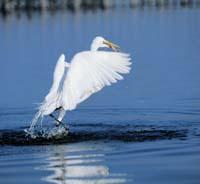
Low lifestyle flight type
The shape and size of the wings are very important when defining the flight mode of each bird. The wings of a txepetx, a grass and a bearded vulture are not the same. Depending on the place of residence and lifestyle of each, the way of flying (and therefore the shape and size of the wings) varies, since each one is adapted to its environment.
Those who inhabit closed plants, such as forests, usually have elliptical wings, that is, short and fairly wide. This form facilitates manoeuvre in small areas. Instead, to fly long distances are not very appropriate wings. Birds that make long distances planning in open areas have wide and long wings. There is nothing but to see what wings the storks or griffon vultures have.
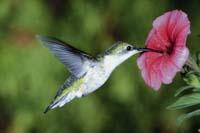
On the other hand, swallows, hawks and others have long, thin and rigid wings. The wings with this shape are very aerodynamic, allowing birds to reach high speeds. In fact, birds with this type of wings are the fastest, being able to reach speeds of up to 200 km/h.
Migration and flight
At certain times of the year, many birds fly thousands of kilometers. It is an activity that requires a lot of energy. They try to make the road as "cheap" as possible, as direct as possible and in group. Migratory birds often fly in groups. Sometimes it is very special --in groups of cranes, for example- the form V that the group adopts. When flying in a group, the air resistance decreases, so they require less energy to take the same route.
In addition to the energy expenditure typical of migration, during migration they depend on other factors that make them consume more or less energy. Wind is especially important. When the sun warms and there is wind in favor of migration, birds fly very high and have no problems to fly properly.
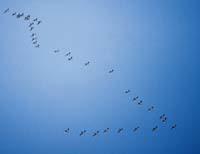
However, when there is no sun (and therefore no thermal current) or there is opposite wind, they do not reach a very high height and encounter several obstacles. In these cases, for example, mountain ranges become difficult to overcome. The birds are forced to change their route and begin to surround the mountain range until they find a valley or hill that allows them to cross.
Another obstacle is the seas. Since the water is heated very slowly, no thermal current is generated over the water. Gliding birds have serious problems crossing large bodies of water from continent to continent. To avoid this problem, black milanos, hawks and many other gliders use the terrestrial thermal currents to reach the highest possible height, from where they depart to the other continent, dropping from top to bottom, striking the wings over the sea to travel the shortest possible distance. So that this difficulty to overcome is the minimum possible, they choose the points with the minimum ranges of sea to cross the sea. For example, the Strait of Gibraltar. During migration, many gliding birds accumulate on the coasts.
Birds that do not depend on thermal currents - one of them is the osprey - do not have as many problems as gliders to cross large bodies of water. They have the same facility to fly over the sea or land. Yes, if they need to get tired and rest, the solutions are not the same on land and sea. On land yes, they can land almost anywhere, but they cannot land at sea. They are put on the islets they meet or on boats when they have no strength to withstand the journey. If steps are not found, some die in the attempt to cross the sea hardly. That is why they too often cross the seas through narrow foothills.
Logically, this migration refers to landbirds, with the opposite problem for seabirds. The problem is that they pass from sea to sea because it is dry between two seas or oceans. Tides are a step for them, a solution to the problem of moving from one ocean to another.
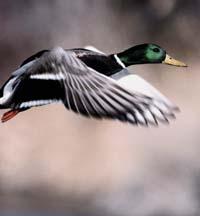
If we had to choose a way to fly, and apparently, it would not be an easy task! Fortunately or unfortunately, we cannot choose this; each animal is the successor of its ancestors and has to live with the characteristics that have touched it to live. With advantages and disadvantages.
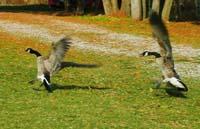
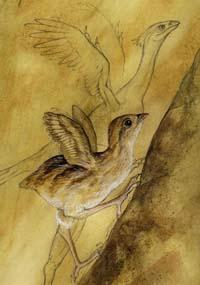
Buletina
Bidali zure helbide elektronikoa eta jaso asteroko buletina zure sarrera-ontzian











